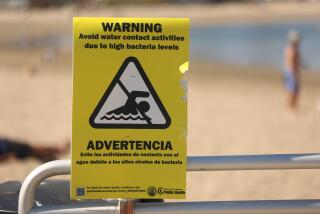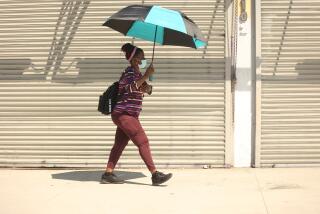It’s Never Too Late to Shun Sun
- Share via
September is a hot month. How safe are you in the sun?
It’s a standard sight at almost any beach along the Orange County coast: Women and men of all ages, stretched out on towels, basking so that the sun can kiss every inch of skin not covered by bathing suits and sunglasses. Then, they roll over after 15 minutes, cooking like a chicken on a backyard rotisserie.
But they’ve got sunscreen, so what’s the harm?
Plenty. Experts warn that safety at the beach means more than not getting clobbered by the waves. Your worst beating may come from the sun.
More than 1 million new cases of skin cancer are reported in the United States each year, according to the Centers for Disease Control and Prevention.
One problem is that many people don’t know the proper way to use sunscreen, says Yorba Linda dermatologist Dr. Alexander Miller.
“You see people at the beach all the time applying sunscreen,” he said.
“What they don’t realize is that it takes time for the skin to absorb the lotion. To be effective, you need to put it on before you even leave home.”
Miller sits on the executive board of the California Society of Dermatology and Dermatologic Surgery. One of its goals is to convince the public that sun damage is a long-term problem--you might not develop cancer until many years later.
“We don’t want to turn people into house hermits,” Miller said. “But too many people out in the sun are not using common sense.”
Here are beach tips from science and health experts at the American Academy of Dermatology:
* Make liberal use of the lotion--at least an ounce with each application.
* Limit your time in the sun; sunscreen provides only limited protection.
* Sunscreen doesn’t last. If you need to be in the sun more than three hours, you must reapply it.
* You must reapply sunscreen after swimming and after sweating profusely, like on a beach run.
* Check the labels. Never buy anything without at least a 15 SPF (sun protection factor).
The big danger, of course, comes from sunburns.
The American Academy of Dermatology estimates that one severe case of sunburn for a young person can double the chances of later developing skin cancer. It estimates that at least 70% of our lifetime exposure to the sun comes before we reach the age of 18. Regular sun protection at that age, it says, can reduce the chances of skin cancer later in life by 78%.
Dr. Roger Ceilley, academy president, adds, “Skin cancer is one of the few diseases that can be minimized if people protect themselves from the sun, especially when they are young.”
Infants, of course, deserve the utmost care. Scientists say infants absorb the same amount of sun exposure in four minutes that adults do in an hour.
Dr. Miller of Yorba Linda says his state group finds another message difficult to get across: You can get too much sun on cloudy days.
“Just because you don’t see the sun shining doesn’t mean it’s not there,” he said.
Here’s another issue sometimes overlooked, the academy says. It’s not just white people who need sunscreen protection. People with darker skin are subject to burns or overexposure too.
It’s never too late to start protecting your skin. And here’s a great tip from Miller: When applying sunscreen, don’t forget the ears.
*
Readers may reach Hicks by calling (714) 966-7789 or e-mail to jerry.hicks@latimes.com


